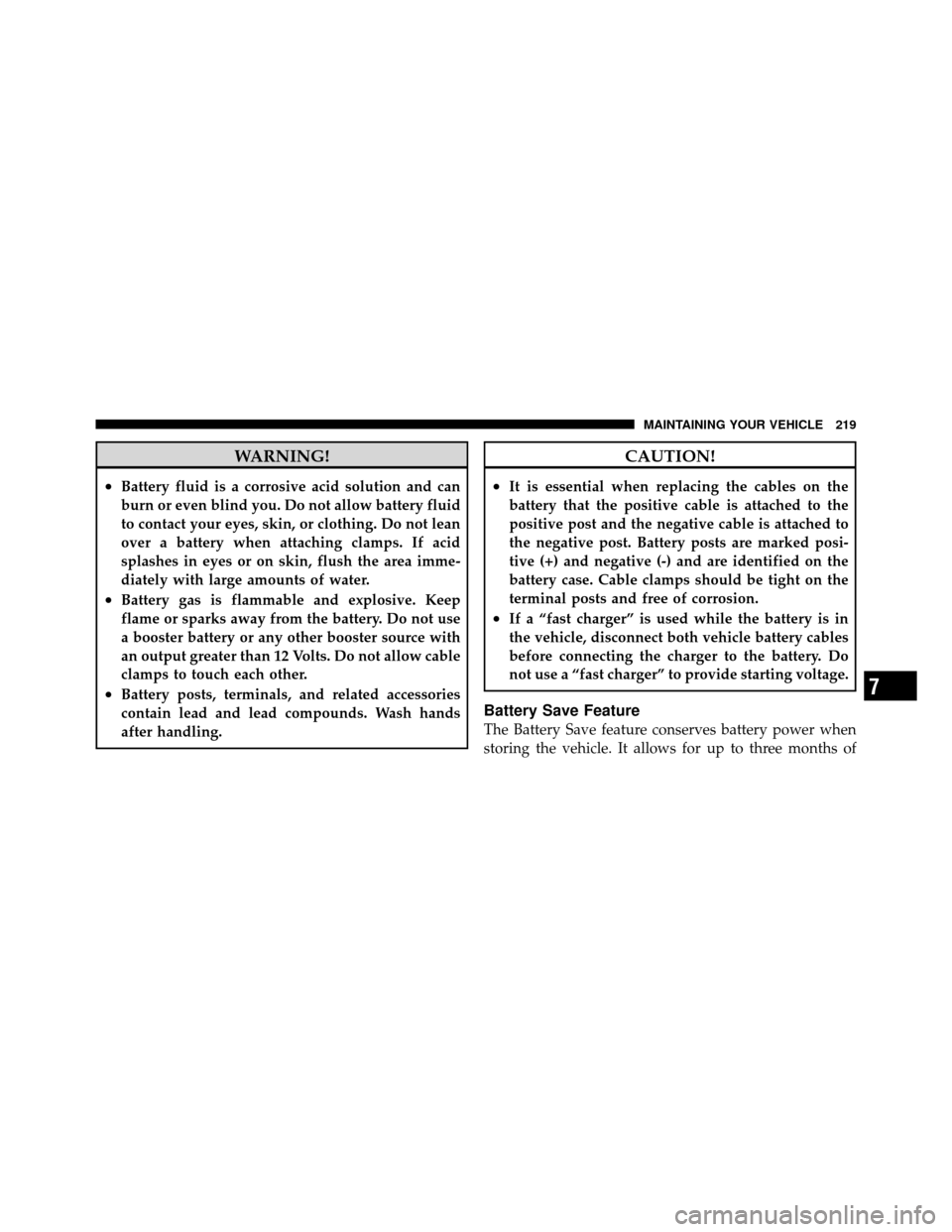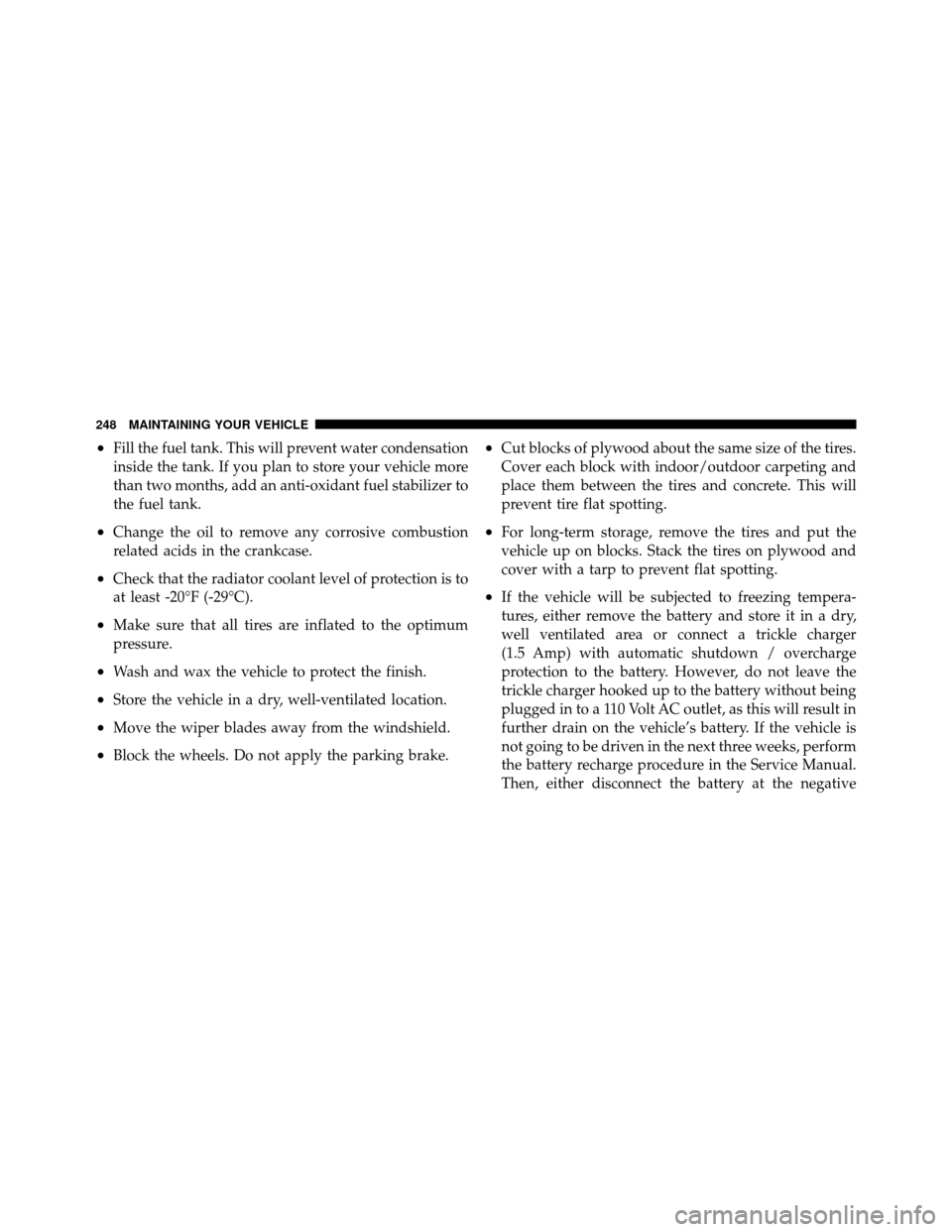Page 222 of 315
To gain access to the battery, remove the floor portion of
the rear compartment carpet.
Accessing The Battery
Battery Location
218 MAINTAINING YOUR VEHICLE
Page 223 of 315

WARNING!
•Battery fluid is a corrosive acid solution and can
burn or even blind you. Do not allow battery fluid
to contact your eyes, skin, or clothing. Do not lean
over a battery when attaching clamps. If acid
splashes in eyes or on skin, flush the area imme-
diately with large amounts of water.
•Battery gas is flammable and explosive. Keep
flame or sparks away from the battery. Do not use
a booster battery or any other booster source with
an output greater than 12 Volts. Do not allow cable
clamps to touch each other.
•Battery posts, terminals, and related accessories
contain lead and lead compounds. Wash hands
after handling.
CAUTION!
•It is essential when replacing the cables on the
battery that the positive cable is attached to the
positive post and the negative cable is attached to
the negative post. Battery posts are marked posi-
tive (+) and negative (-) and are identified on the
battery case. Cable clamps should be tight on the
terminal posts and free of corrosion.
•If a “fast charger” is used while the battery is in
the vehicle, disconnect both vehicle battery cables
before connecting the charger to the battery. Do
not use a “fast charger” to provide starting voltage.
Battery Save Feature
The Battery Save feature conserves battery power when
storing the vehicle. It allows for up to three months of
7
MAINTAINING YOUR VEHICLE 219
Page 224 of 315

storage time without losing radio and engine controller
memory. Using this feature is an alternative to discon-
necting the battery.
NOTE:This vehicle is designed to sit in storage with a
fully charged battery for up to 30 days. If you plan to
store the vehicle longer than 30 days, we recommend
doing one of the following:
•Disconnect the battery.
•Use the battery charger.
•Put the vehicle into Battery Save mode (3-month
charge).
To Activate the Battery Save Feature
1. Insert the key into the ignition switch.
2. Cycle the ignition switch from OFF/LOCK to ACC
four times. Leave the switch in the OFF/LOCK position
after the fourth cycle. 3. Push the driver’s power door lock switch in the up
direction. A single chime will sound and the horn will
chirp to indicate that the process has begun.
4. Remove the key from the ignition switch and exit the
vehicle. The Battery Save Feature will be enabled 45 sec-
onds after all doors are closed.
NOTE:
•Turning the ignition switch to the ON/RUN position
at any time will cancel activation of the Battery Save
Feature.
•The Remote Keyless Entry (RKE) and the exterior
passenger door handle will not work when the Battery
Save feature is enabled. Enter the vehicle by using the
key to unlock the door manually and by using the
exterior driver door handle to open the door.
220 MAINTAINING YOUR VEHICLE
Page 225 of 315

•The Vehicle Security Alarm is disabled when the
Battery Save Feature is enabled. Therefore, the vehicle
is not protected when the Battery Save Feature is
enabled.
•The exterior and interior lighting functions will not
work when the Battery Save Feature is enabled.
To Deactivate the Battery Save Feature
1. Press the exterior driver’s door handle once to wake
up the vehicle. Then, press the handle again to open the
door.
NOTE:If the door does not open (vehicle is armed),
press the RKE UNLOCK button to unlock the vehicle.
2. Insert the key into the ignition switch.
3. Turn the ignition switch to the ON/RUN position. The
Battery Save Feature will turn off. NOTE:
If the ignition switch is NOT turned to ON/
RUN position, the Battery Save Feature will be enabled
45 seconds after the driver’s door is closed.
Air Conditioner Maintenance
For best possible performance, your air conditioner
should be checked and serviced by an authorized dealer
at the start of each warm season. This service should
include cleaning of the condenser fins and a performance
test. Drive belt tension should also be checked at this
time.
CAUTION!
Do not use chemical flushes in your air conditioning
system as the chemicals can damage your air condi-
tioning components. Such damage is not covered by
the New Vehicle Limited Warranty.7
MAINTAINING YOUR VEHICLE 221
Page 248 of 315
FUSES
Power Distribution Center
The Power Distribution Center is located in the engine
compartment on the driver’s side of the vehicle. This
center contains fuses and relays.
Cavity Car-tridge
Fuse Mini-
Fuse
Description
1 40 Amp Green — Blower Motor
2 40 Amp Green — Anti-Lock Brakes (ABS)
Pump Feed/Starter
3 30 Amp Pink — Body Control Module
(BCM) – Battery Feed
4 20 Amp Blue — Amplifier
5 30 Amp Pink — Ignition Switch Run/
Accessory Feed – Win-
dows
6 40 Amp Green — Body Control Module
(BCM) – Battery Feed
7 30 Amp Pink — Anti-Lock Brakes (ABS)
Module
Power Distribution Center
244 MAINTAINING YOUR VEHICLE
Page 252 of 315

•Fill the fuel tank. This will prevent water condensation
inside the tank. If you plan to store your vehicle more
than two months, add an anti-oxidant fuel stabilizer to
the fuel tank.
•Change the oil to remove any corrosive combustion
related acids in the crankcase.
•Check that the radiator coolant level of protection is to
at least -20°F (-29°C).
•Make sure that all tires are inflated to the optimum
pressure.
•Wash and wax the vehicle to protect the finish.
•Store the vehicle in a dry, well-ventilated location.
•Move the wiper blades away from the windshield.
•Block the wheels. Do not apply the parking brake.
•Cut blocks of plywood about the same size of the tires.
Cover each block with indoor/outdoor carpeting and
place them between the tires and concrete. This will
prevent tire flat spotting.
•For long-term storage, remove the tires and put the
vehicle up on blocks. Stack the tires on plywood and
cover with a tarp to prevent flat spotting.
•If the vehicle will be subjected to freezing tempera-
tures, either remove the battery and store it in a dry,
well ventilated area or connect a trickle charger
(1.5 Amp) with automatic shutdown / overcharge
protection to the battery. However, do not leave the
trickle charger hooked up to the battery without being
plugged in to a 110 Volt AC outlet, as this will result in
further drain on the vehicle’s battery. If the vehicle is
not going to be driven in the next three weeks, perform
the battery recharge procedure in the Service Manual.
Then, either disconnect the battery at the negative
248 MAINTAINING YOUR VEHICLE
Page 253 of 315

terminal or use the “Battery Save Feature” to conserve
battery power. Refer to “Maintenance Procedures/
Battery Save Feature” in “Maintaining Your Vehicle”
for further information.
NOTE: Disconnecting the battery causes the engine
control system to lose memory of some “learned” func-
tions. After reconnecting the battery, the engine may run
rough until the control module “relearns” these func-
tions. Using the Battery Save Feature will prevent the
engine controller from loosing its memory.
CAUTION!
Use care when disconnecting the remote positive
cable. It is connected to the battery and can short out
to any metal on the vehicle. Always tape or wrap the
exposed cable end to prevent electrical shorts. Check the battery every four to six weeks to ensure that
the voltage is above 12.40 Volts. The voltage will drop
more rapidly in hot temperatures. If battery voltage
drops below 12.40 Volts, follow the battery recharge
procedure in the Service Manual.
NOTE:
To help prevent the battery from discharging
during shorter periods of inactivity, perform the follow-
ing:
1. Make sure that the trunk/liftgate, hood, doors, win-
dows, and convertible top are completely closed.
2. Make sure that Remote Keyless Entry (RKE) transmit-
ter is operating and that the battery is good.
3. Make sure that the HOOD, TRUNK/LIFTGATE, and
DOOR switches are in adjustment. Perform the quick
system check, which follows:
Use the remote transmitter to set the alarm. If the alarm
SET light comes on and flashes, the system is operating7
MAINTAINING YOUR VEHICLE 249
Page 270 of 315

At Each Stop for Fuel
•Check the engine oil level about five minutes after a
fully warmed engine is shut off. Checking the oil level
while the vehicle is on level ground will improve the
accuracy of the oil level reading. Add oil only when
the level is at or below the ADD or MIN mark.
•Check the windshield washer solvent and add if
required.
Once a Month
•Check tire pressure and look for unusual wear or
damage.
•Inspect the battery, and clean and tighten the terminals
as required.
•Check the fluid levels of the coolant reservoir, brake
master cylinder, power steering, and transmission,
and add as needed.
•Check all lights and all other electrical items for correct
operation.
At Each Oil Change
•Change the engine oil filter.
•Inspect the exhaust system.
NOTE: Also, inspect the exhaust system if you notice a
change in the sound of the exhaust system, or if the
exhaust fumes can be detected inside the vehicle.
•Inspect the brake hoses.
•Inspect the suspension components.
•Lubricate door hinges and check springs.
•Check the engine coolant level, hoses, and clamps.
•Check power steering fluid level.
8
M A I
N T
E
N A
N CE
S
C
H E
D
U L
E
S266 MAINTENANCE SCHEDULES